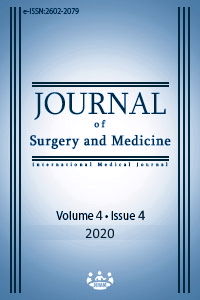Can rigid ureteroscopic lithotripsy be an alternative to flexible ureteroscopic lithotripsy in the treatment of isolated renal pelvis stones smaller than 2 cm?
Keywords:
Rigid, Flexible, Ureteroscopic lithotripsy, Renal pelvis stoneAbstract
Aim: Although flexible ureteroscopy (FURS) is preferred over rigid ureteroscopy in the treatment of kidney stones, rigid ureteroscopy (RURS) is also often sufficient for reaching the renal pelvis in many patients. In this study, we aimed to analyze the results of rigid (RURSL) and flexible ureteroscopic lithotripsy (FURSL) for the treatment of isolated renal pelvic stone (IRPS) <2 cm in size by evaluating stone-free rates, operation times, and associated complications.
Methods: This retrospective cohort study included patients who underwent RURSL (group 1, n=24) and FURSL (group 2, n=21) for IRPS <2 cm in size between June 2012 and May 2017. RURS was routinely performed in all patients. The stones reached by rigid ureteroscope were fragmented with holmium laser. When the stones were not reachable by rigid ureteroscope, FURS was performed, and the stone was fragmented with the same laser energy.
Results: In 24 of 45 (53.3%) patients, stones were reached by rigid ureteroscope and fragmented with holmium laser. In the remaining 21 (46.7%) patients, the stones could not be reached by rigid ureteroscope, and they were managed with FURS and fragmented with the same laser energy source. RURS was successful in reaching renal pelvic stones in 15 of 25 (60%) female patients; however, the stones were reached in 9 (45%) of 20 male patients (P=0.173). There was no significant difference between the two groups in terms of age, gender, side of stone, mean stone size, hospital stay, stone-free rates, and associated complications (P=0.298, P=0.396, P=0.775, P=0.266, P=0.742, P=0.428, P=0.186, respectively). The mean operative times were significantly lower in RURSL group than in FURSL group, and they were 66.75 (15.77) min and 89.54 (17.71) min, respectively (P<0.001).
Conclusions: FURSL is a more appropriate procedure for the treatment of kidney stones; however, it should be kept in mind that RURSL is an alternative procedure to FURSL with shorter operation time, similar stone-free rates and similar complication rates for IRPS in selected cases.
Downloads
References
Kisa E, Uçar M, Yücel C, Süelözgen T, İlbey Y. Effects of the stone density on the outcome of percutaneous nephrolithotomy in pediatric population. J Surg Med. 2019;3(7):498-502. doi: 10.28982/josam.587965.
Türk C, Neisius A, Petrik A, Seitz C, Skolarikos A, Thomas K. Guidelines on urolithiasis. EAU 2020.
Atis G, Gurbuz C, Arikan O, Canat L, Kilic M, Caskurlu T. Ureteroscopic management with laser lithotripsy of renal pelvic stones. J Endourol. 2012;26(8):983–7. doi: 10.1089/end.2011.0664.
Süer E, Gülpinar Ö, Özcan C, Göğüş Ç, Kerimov S, Şafak M. Predictive factors for flexible ureterorenoscopy requirement after rigid ureterorenoscopy in cases with renal pelvic stones sized 1 to 2 cm. Korean J Urol. 2015;56(2):138–42. doi: 10.4111/kju.2015.56.2.138.
Matlaga BR, Assimos DG. Changing indications of open stone surgery. Urology. 2002;59(4):490–4. doi: 10.1016/s0090 4295(01)01670-3.
El-Nahas AR, Ibrahim HM, Youssef RF, Sheir KZ. Flexible ureterorenoscopy versus extracorporeal shock wave lithotripsy for treatment of lower pole stones of 10-20 mm. BJU Int. 2012;110(6):898–902. doi: 10.1111/j.1464-410X.2012.10961.x.
Fabrizio MD, Behari A, Bagley DH. Ureteroscopic management of intrarenal calculi. J Urol. 1998;159(4):1139–43.
Miernik A, Schoenthaler M, Wilhelm K, Wetterauer U, Zyczkowski M, Paradysz A, et al. Combined semirigid and flexible ureterorenoscopy via a large ureteral access sheath for kidney stones >2 cm: a bicentric prospective assessment. World J Urol. 2014;32(3):697–702. doi: 10.1007/s00345-013-1126-z.
Basillote JB, Lee DI, Eichel L, Clayman RV. Ureteroscopes: flexible, rigid, and semirigid. Urol Clin North Am. 2004;31(1):21–32. doi: 10.1016/S0094-0143(03)00094-6.
Sung JC, Springhart WP, Marguet CG, L'Esperance JO, Tan YH, Albala DM, et al. Location and etiology of flexible and semirigid ureteroscope damage. Urology. 2005;66(5):958–63. doi: 10.1016/j.urology.2005.05.033.
Bryniarski P, Paradysz A, Zyczkowski M, Kupilas A, Nowakowski K, Bogacki R. A randomized controlled study to analyze the safety and efficacy of percutaneous nephrolithotripsy and retrograde intrarenal surgery in the management of renal stones more than 2 cm in diameter. J Endourol. 2012;26(1):52–7. doi: 10.1089/end.2011.0235.
Zengin K, Şener NC, Tanık S, Albayrak S, Gürdal M. The feasibility of semi-rigid ureterorenoscopy in small sized renal pelvic stones. Bozok Med J. 2014;4(2):1-4
Breda A, Angerri O. Retrograde intrarenal surgery for kidney stones larger than 2.5 cm. Curr Opin Urol. 2014;24(2):179–83. doi: 10.1097/MOU.0000000000000030.
Sabnis RB, Ganesamoni R, Doshi A, Ganpule AP, Jagtap J, Desai MR. Micropercutaneous nephrolithotomy (microperc) vs retrograde intrarenal surgery for the management of small renal calculi: a randomized controlled trial. BJU Int. 2013;112(3):355–61. doi: 10.1111/bju.12164.
Demir DO, Doluoglu OG, Yildiz Y, Bozkurt S, Ayyildiz A, Demirbas A. Risk Factors for Infectious Complications in Patients Undergoing Retrograde Intrarenal Surgery. J Coll Physicians Surg Pak. 2019;29(6):558–62. doi: 10.29271/jcpsp.2019.06.558.
Xu Y, Min Z, Wan SP, Nie H, Duan G. Complications of retrograde intrarenal surgery classified by the modified Clavien grading system. Urolithiasis. 2018;46(2):197–202. doi: 10.1007/s00240-017-0961-6.
Fan S, Gong B, Hao Z, Zhang L, Zhou J, Zhang Y, et al. Risk factors of infectious complications following flexible ureteroscope with a holmium laser: a retrospective study. Int J Clin Exp Med. 2015;8(7):11252-9.
Takazawa R, Kitayama S, Tsujii T. Successful outcome of flexible ureteroscopy with holmium laser lithotripsy for renal stones 2 cm or greater. Int J Urol. 2012;19(3):264–7. doi: 10.1111/j.1442-2042.2011.02931.x.
Senocak C, Ozcan C, Sahin T, Yilmaz G, Ozyuvali E, Sarikaya S, et al. Risk Factors of Infectious Complications after Flexible Uretero-renoscopy with Laser Lithotripsy. Urol J. 2018 Jul 10;15(4):158-63. doi: 10.22037/uj.v0i0.3967.
Martov A, Gravas S, Etemadian M, Unsal A, Barusso G, D'Addessi A, et al. Clinical Research Office of the Endourological Society Ureteroscopy Study Group. Postoperative infection rates in patients with a negative baseline urine culture undergoing ureteroscopic stone removal: a matched case-control analysis on antibiotic prophylaxis from the CROES URS global study. J Endourol. 2015;29(2):171-80. doi: 10.1089/end.2014.0470.
Baseskioglu B. The Prevalence of Urinary Tract Infection Following Flexible Ureterenoscopy and the Associated Risk Factors. Urol J. 2019;16(5):439–42. doi: 10.22037/uj.v0i0.4340.
Downloads
- 878 866
Published
Issue
Section
How to Cite
License
Copyright (c) 2020 Ali Akkoç, Murat Ucar
This work is licensed under a Creative Commons Attribution-NonCommercial-NoDerivatives 4.0 International License.
















